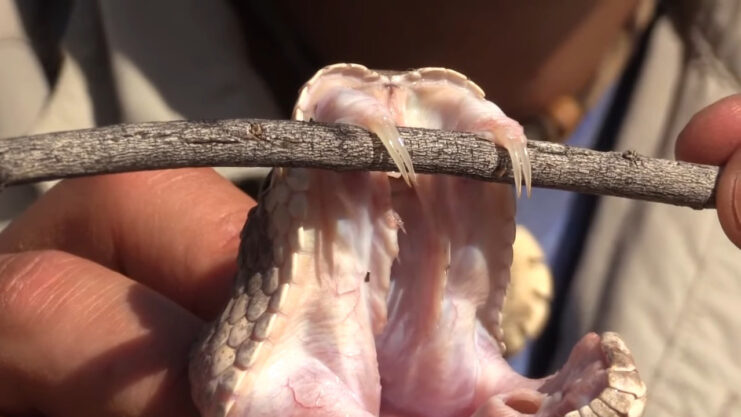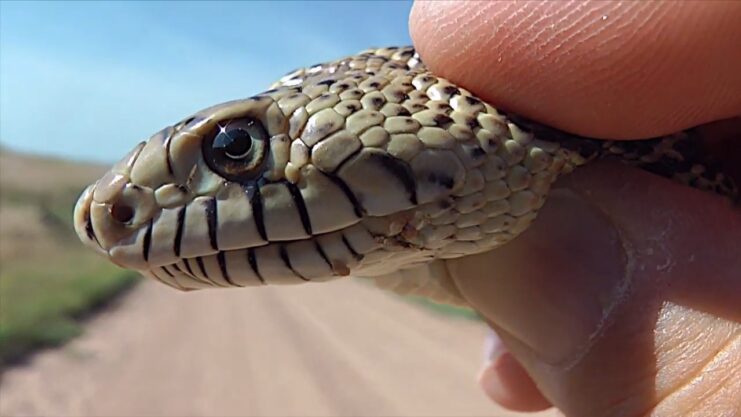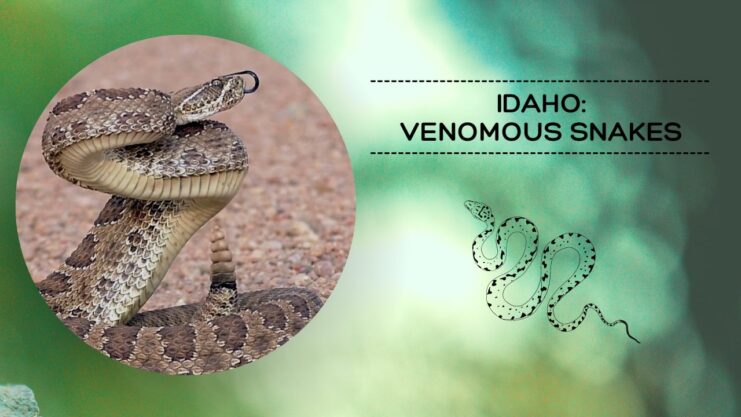Welcome to the untamed wilderness of Idaho, where the majestic landscapes are not without their hidden dangers. This state may be known for its breathtaking mountains and pristine rivers, but it also harbors a secret: the presence of venomous serpents.
Prepare to unravel the mysteries of Idaho’s venomous snake species, their habitats, and the fascinating adaptations that enable their survival in this environment. Gather your curiosity and join us as we delve into the intriguing realm of venomous snakes in this rugged state!
1. The Western Rattlesnake

Idaho is home to two venomous snakes: the Western Rattlesnake and the Prairie Rattlesnake. The Western Rattlesnake is commonly found in rocky areas and can also be spotted near water as it possesses swimming abilities. Recognizable by its triangular-shaped head, patterned scales ranging from tan to brown to gray, and its distinctive rattle sound.
The Western Rattlesnake is adaptable and can be found in a variety of habitats, including forests, prairies, deserts, and even rocky hillsides. They are primarily nocturnal and are known for their defensive behavior when threatened. They coil their bodies, rattle their tails, and can strike with a fast, accurate lunge.
Key Features:
- Distinctive rattle at the end of the tail
- Triangular head and narrow neck
- Heat-sensing pits between the eyes and nostrils
- Variable coloration, usually matching their habitat for camouflage
- Venomous fangs that can deliver a potent bite
2. The Prairie Rattlesnake

The Prairie Rattlesnake, Idaho’s other native venomous snake, is mostly found in Central Idaho, especially in the Frank Church wilderness area. It has been identified as a species separate from the Western Rattler only in the last 15 years.
This species shares similar looks and habits with the Western Rattlesnake. Despite their venomous nature, these snakes play a crucial role in the ecosystem, helping control the population of pests like mice and rats.
Key Features:
- Distinctive Rattle: The Prairie Rattlesnake is known for its iconic rattle, made of interlocking segments that create a buzzing sound when vibrated. This is a warning signal to potential predators.
- Heat-Sensing Pits: These snakes are equipped with heat-sensing pits on their heads, which allow them to detect warm-blooded prey, even in the dark.
- Coloration and Pattern: Prairie Rattlesnakes typically have a brown to greenish-gray base color, patterned with darker oval blotches along the back. This camouflage helps them blend into their surroundings.
- Venomous Bite: The Prairie Rattlesnake possesses a potent venom, which it uses to immobilize its prey. While not typically fatal to healthy adults, a bite can cause severe symptoms and requires immediate medical attention.
| Snake Species | Length | Habitat | Behavior | Interesting Facts |
|---|---|---|---|---|
| Western Rattlesnake | Up to 3 feet | Rocky areas, around the water | Nocturnal, hunts at night by sensing heat from their prey. Occasionally active during the day, especially during cooler weather. | This snake has a unique adaptation to help it hunt. It possesses a heat-sensing organ, known as a pit organ, located between the eye and the nostril on either side of the head. This organ allows the snake to detect minute differences in temperatures, helping it to locate warm-blooded prey, even in complete darkness. |
| Prairie Rattlesnake | Varies | Central Idaho, especially in the Frank Church wilderness area | Similar to the Western Rattlesnake, they are also nocturnal and hunt by sensing heat from their prey. | Unlike many other snake species, the Prairie Rattlesnake gives birth to live young rather than laying eggs. This is an adaptation to their environment, as the cooler climate of their habitat would make it difficult for eggs to incubate successfully. The young snakes are born fully formed and are capable of hunting within a few weeks of birth. |
Venomous Snakebites in Idaho
Since 2017, Idaho has reported 44 snakebite incidents, with nearly 82% of those (36 bites) being from venomous species. Out of the snakebite incidents in Idaho during the last two years, rattlesnakes were responsible for twenty-seven cases, while the remaining nine cases were attributed to unidentified species belonging to the pit viper family known as “unknown crotaline” snakes.
Although venomous snakes exist in Idaho, records from the Idaho Department of Health and Welfare reveal that there have been no deaths caused by venomous snakebites in the past 22 years. On average, around twelve snakebite cases are reported annually in Idaho.
Safety Tips
Snake safety is crucial, especially in areas where venomous snakes are present. Here are some tips to help you stay safe:
- Be Aware of Your Surroundings: Snakes often hide in tall grass, under rocks, or in piles of leaves. Always watch where you step and avoid reaching into areas where you can’t see.
- Wear Protective Clothing: If you’re in an area known for snakes, wear boots and long pants to protect your legs and feet.
- Don’t Disturb Snakes: If you see a snake, don’t try to move it or provoke it. Most snake bites occur when people accidentally step on snakes or try to handle them.
- Know What to Do in Case of a Snakebite: If you or someone else is bitten, seek medical attention immediately. Try to remember the color and shape of the snake, but don’t attempt to capture it. This information can help medical professionals determine the best course of treatment.
- Educate Yourself: Learn about the types of snakes in your area. Knowing which snakes are venomous and what they look like can help you avoid them.
Always keep in mind that snakes could be anywhere in nature, never provoke them as they will bite you in self defense. Did you know that Florida is home to many venomous snakes? Many people in Florida get bitten because they’re not careful enough.
Non-Venomous Snake Species
Idaho hosts not only venomous snakes but also a variety of non-venomous snakes that play a crucial role in the local ecosystem. These include the North American Racer, Gopher Snake, and the Terrestrial Garter Snake.
The North American Racer actively roams dry terrains, such as the Boise Foothills, during the day. Known for their speed, they glide rather than undulate when moving.
You can typically find Gopher snakes, also known as bullsnakes, in the Boise Foothills. They are sometimes mistaken for rattlesnakes due to their similar markings and defensive behaviors.
Terrestrial Garter Snakes, the most aquatic snakes in Idaho, inhabit areas near water where they feed on small fish and tadpoles. However, they are also capable of adapting to drier habitats.
FAQs
What should I do if I encounter a venomous snake in my home or yard in Idaho?
If you encounter a venomous snake in your home or yard, it’s important not to attempt to handle or remove the snake yourself. Instead, contact a local wildlife removal service or animal control agency who can safely remove the snake.
Are there any specific first aid measures to take if bitten by a venomous snake in Idaho?
If bitten by a venomous snake, it’s crucial to seek medical attention immediately. While waiting for medical help, try to remain calm, keep the bitten area below heart level if possible, and avoid any attempts to suck out the venom or apply a tourniquet.
Are there any specific seasons when venomous snakes in Idaho are more active?
While the activity of snakes can depend on various factors, generally, snakes are more active in warmer months, typically from spring to fall. However, they can also be active on warm days in winter.
Are there any laws in Idaho regarding the capture or killing of venomous snakes?
Laws regarding the capture or killing of wildlife, including venomous snakes, can vary by state and locality. It’s important to check with local wildlife agencies or departments for specific regulations in Idaho.
What should I do if I find a baby venomous snake in Idaho?
Baby venomous snakes can still pose a threat, as they are capable of injecting venom from a very young age. If you find a baby venomous snake, do not attempt to handle it. Instead, contact a local wildlife removal service or animal control agency.
Conclusion
Idaho may not have many venomous snakes, but it’s still crucial to stay vigilant and informed about the ones that are there. Understanding their characteristics, habitats, and risks can help keep us safe and respectful.
When exploring outdoors, especially in snake-prone areas, exercise caution. By coexisting harmoniously with wildlife, we can appreciate the vital role venomous snakes play in Idaho’s ecosystem and continue to enjoy its beauty and adventure.
Related Posts:
- 8 Great Places To Go Glamping In Norway 2024 -…
- 4 Most Venomous Snakes in Arizona - Stay Safe on…
- Unveiling Venomous Snakes in Georgia: An Exciting…
- Todd Road Jail - Safety and Security of the Facility
- Bitcoin Applications: What Works and What Doesn't,…
- 5 Best Camping in Idaho: Find the Camping Treasures…




















